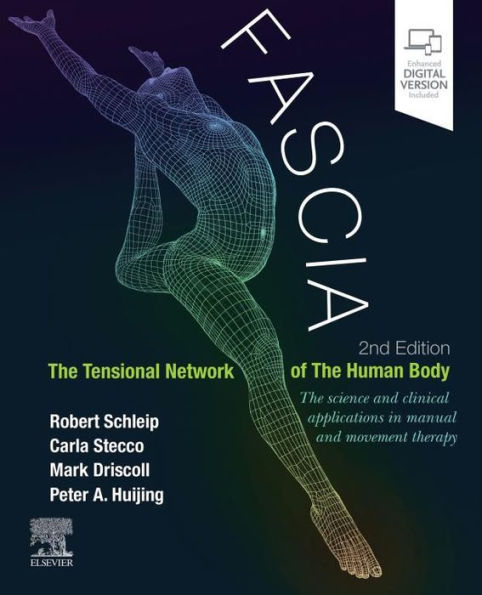
Fascia: The Tensional Network of the Human Body - E-Book: Fascia: The Tensional Network of the Human Body - E-Book
566
Fascia: The Tensional Network of the Human Body - E-Book: Fascia: The Tensional Network of the Human Body - E-Book
566eBook
Related collections and offers
Overview
The role of the fascia in musculoskeletal conditions and as a body-wide communication system is now well established. Fascia: The Tensional Network of the Human Body constitutes the most comprehensive foundational textbook available that also provides the latest research theory and science around fascia and their function.
This book is unique in offering consensus from scientists and clinicians from across the world and brings together the work of the group behind the international Fascia Research Congress. It is ideal for advanced sports physiotherapists /physical therapists, musculoskeletal/orthopaedic medicine practitioners, as well as all professionals with an interest in fascia and human movement.
The comprehensive contents lay the foundations of understanding about fascia, covering current scientific understanding of physiology and anatomy, fascial-related disorders and associated therapies, and recently developed research techniques.
- Full colour illustrations clearly show fascia in context
- New content based on latest research evidence
- Critical evaluation of fascia-oriented therapies by internationally trusted experts
- Chapter outlines, key points and summary features to aid navigation
- Accompanying e-book version include instructional videos created by clinicians

Product Details
| ISBN-13: | 9780702084133 |
|---|---|
| Publisher: | Elsevier Health Sciences |
| Publication date: | 12/08/2021 |
| Sold by: | Barnes & Noble |
| Format: | eBook |
| Pages: | 566 |
| File size: | 24 MB |
| Note: | This product may take a few minutes to download. |
About the Author
Mark Driscoll, Eng., PhD. is a Professor of Mechanical Engineering at McGill University, in Montreal, Canada. His published research focuses on the biomechanics of the spine from the perspective of devising an improved understanding of stability, diagnostics, and/or treatments – having a particular focus on the involvement of soft tissue such as fascia. He Chaired the scientific committees of the 2018 and 2022 Fascia Research Congresses and was elected as the first President of the Fascia Research Society in 2020. Dr. Driscoll is also the Natural Sciences and Engineering Research Council of Canada Chair for Design Engineering for Interdisciplinary Innovation of Medical Technologies. As the founder and director of the Musculoskeletal Biomechanics Research Lab at McGill, Dr. Driscoll has received many awards for his research and corresponding inventions which serve in assisting people with disabilities around the world.
Table of Contents
SECTION I SCIENTIFIC FOUNDATIONS
Part 1 Anatomy of the fascial body
1.1 General anatomy of muscular fasciae
1.2 Somatic fascia
1.3 Fascia superficialis
1.4 Deep fascia of the shoulder and arm
1.5 Deep fascia of the lower limbs
1.6 The thoracolumbar fascia: An integrated functional view of the anatomy of the TLF and coupled structures
1.7 The deeper fasciae of the neck and ventral torso
1.8 Visceral fascia
1.9 Membranous structures within the cranial bowl and intraspinal space
1.10 Diaphragmatic structures
Part 2 Fascia as an organ of communication
2.1 Fascia as an organ of communication
2.2 Proprioception
2.3 Interoception: A new correlate for intricate connections between fascial receptors, emotion and self recognition
2.4 Nociception: The thoracolumbar fascia as a sensory organ
2.5 Fascia as a body-wide communication system
Part 3 Fascial force transmission
3.1 Force transmission and muscle mechanics: General principles
3.2 Myofascial force transmission: An introduction
3.3 Myofascial chains: A review of different models
3.4 Anatomy trains and force transmission
3.5 Biotensegrity: The mechanics of fascia
3.6 The subcutaneous and epitendinous tissue behaviour of the multimicrovacuolar sliding system
Part 4 Physiology of fascial tissues
4.1 The Physiology of fascia: An introduction
4.2 Fascia is alive: How cells modulate the tonicity and architecture of fascial tissues
4.3 Extracellular matrix
4.4 The influence of pH and other metabolic factors on fascial properties
4.5 Fluid dynamics in fascial tissues
SECTION II CLINICAL APPLICATION
Part 5 Fascia-related disorders
5.1 Fascia-related disorders: An introduction
5.2 Dupuytren’s disease and other fibrocontractive disorders
5.3 ‘Frozen shoulder’
5.4 Spastic paresis
5.5 Diabetic foot
5.6 Scleroderma and related conditions
5.7 Trigger points (TrP) as a fascia-related disorder
5.8 Fascia-related disorders: hypermobility
5.9 Anatomy of the plantar fascia
Part 6 Diagnostic procedures for fascial elasticity
6.1 Diagnostic procedures for fascial elasticity : An introduction
6.2 Fascial palpation
6.3 Hypermobility and the hypermobility syndrome: assessment and management
Part 7 Fascia-oriented therapies
7.1 Inclusion criteria and overview
7.2 Trigger Point Therapy
7.3 Rolfing® Structural Integration
7.4 Myofascial induction approaches
7.5 Osteopathic manipulative therapies and fascia
7.6 Connective tissue manipulation
7.7 Fascial manipulation
7.8 Managing dysfunctional scar tissue
7.9 Acupuncture as a fascia-oriented therapy
7.10 Gua shua
7.11 Prolotherapy
7.12 Neural therapy
7.13 Dynamic fascial release: Manual and tool assisted vibrational therapies
7.14 Graston Technique®:A contemporary instrument assisted mobilization method for the evaluation & treatment of soft tissue lesions
7.15 The Fascial Distortion Model
7.16 Frequency specific microcurrent
7.17 Surgery and scarring
7.18 Temperature effects on fascia
7.19 Neurodynamics: Movement for neuropathic pain states
7.20 Stretching and fascia
7.21 Fascia in yoga therapeutics
7.22 Pilates and Fascia: The art of ‘Working In’
7.23 Nutrition model to reduce inflammation in musculoskeletal and joint diseases
7.24 Fascial fitness: Suggestions for a fascia oriented training approach in sports and movement therapies
SECTION III RESEARCH DIRECTIONS
Part 8 Fascia research: methodological challenges and new directions
8.1 Fascia, the clinic and fundamental scientific research: Considering the scientific process
8.2 Imaging: Ultrasound
8.3 MRI and Elastography
8.4 Roles of fascia in molecular biology of adaptation of muscle size
8.5 Mathematical modelling
Glossary
